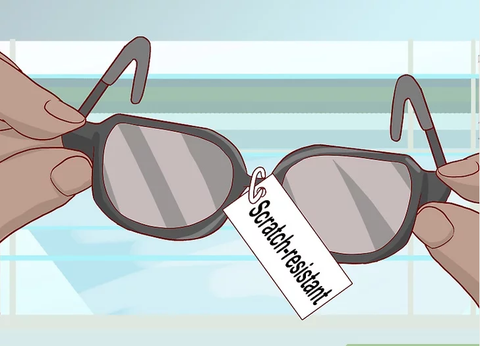How to pick a sunglasses
- If your idea of shopping for sunglasses is trying on a variety of pairs and glancing at the mirror, these instructions will take it to another whole level. Have you ever thought about UV protection? Durability? Visibility? The shape of your head and face? There's more to sunglasses shopping than looking good!

- 1.Aim to protect your eyes first and foremost. Excessive exposure to UV radiation can cause a variety of problems for your eyes such as cataracts, burns, and cancer.

- 2.If you want your sunglasses to protect you from these risks, look for pairs that block at least 99% of UVB rays and at least 95% of UVA rays. Also look for the amount of cover the sunglasses provide. Look at how much you can see around the frames––will the sunglasses let in sun from the top or sides?
- Are you getting these sunglasses for sports or spending significant time outdoors? Choose ones with a nice close fit, possibly with rubber grips on the arms. If they are for fishing or use on water, polarization is a must; polarized glasses provide more sun protection.

-
3.Don't buy sunglasses if they're labeled as "cosmetic" or don't provide any information on UV protection. Look for scratch resistance, many lenses have very fragile coatings. If you are spending much money, you want them to last. Fortunately damaged lenses can be replaced for most models.

-
1.Select a size. Sunglasses come in all shapes and sizes! Generally, finding a contrast between your face shape and the frame shape will look good. For example, if you have a round face, more angular frames will work well, and if your face is more square, a rounder softer frame shape will look good. Here are a few popular styles:
- Mirrorshades - Mirrored coating on surface. Used a lot by police officers in the US. They usually come in an aviator or wraparound shape.
- Aviators - Teardrop-shaped lens and thin metal frames. Often used by pilots, military personnel, and law enforcement personnel in the US. Good with any face shape, but best with an oval shape.
- Wayfarers/Spicolis - Popular in the 1950s and 1960s. Worn by Audrey Hepburn in the 1961 movie Breakfast at Tiffany's.
- Teashades - Popularized by John Lennon and Ozzy Osbourne. They're not very effective at keeping light out of your eyes, though.
- Wraparounds - Associated with athletics and extreme sports.
- Oversized - Associated with models and movie stars. Glamorous, darling.

- 2.Use the shape of your face to help you pick your sunglasses shape. The following face shape matched to sunglasses style is recommended:
- Oval face: The oval type usually has the "perfect face shape", and can wear any style of glasses. Avoid frames that are either too thick or too thin. Don't choose frames wider than your face width.
- Square face: Because this face shape has very straight, pronounced jawline and edges, choose round glasses to balance out these features. Make sure the frames are not too thick. Try to choose wider sunglasses and avoid rectangular glasses with sharp corners.
- Round face: A round face has plumper cheeks and chin. Choose polygonal or square sunglasses that have an angle design to balance this out. Look for thicker frames.
- Long face: Choose larger lenses and the polygonal frame to modify a long face. Popular retro glasses and sports glasses can be considered.
- Flat face: Choose darker lenses and frames to highlight the contours of the face. Bright colors can also make expressions more vivid!

-
3.Make sure the sunglasses fit properly. Try them on and make sure they don't pinch around your head. The weight should be evenly distributed between your ears and nose, and your eyelashes shouldn't touch the frame or lenses. Glasses should be your stand on the bridge of the nose and ears; if they feel inclined to one side, you need to adjust them. In addition, use the measuring rule that an "eyelash is less than the lens".
Make sure that the lens area is not too small, so that it will be able to block sunlight.
Part 3: Choosing Lens Color Wisely

-
1.Note that the color of the lenses doesn't just affect your fashion statement, it affects how well you detect contrast and differentiate colors. Some colors enhance contrast, which can be useful; however, this is often at the expense of color distinction, which can cause problems (when you're driving, for example, and need to be able to clearly differentiate the colors of a traffic light). Some sunglasses even come with interchangeable lenses so you can change the color easily, depending on what you're doing.
- Gray lenses reduce light intensity without affecting contrast or distorting colors.
- Brown lenses partially enhance contrast by blocking some blue light. Good for snow sports.Also generally good for hunting in bright light, against open backgrounds.
- Amber/yellow lenses significantly enhance contrast because they block most or all blue light, and that makes them popular among hunters who benefit from that contrast when looking at targets against the sky. They're bad, however, for any activity that requires color recognition (like driving!). Good for snow sports.
- Red/orange lenses are good for snow sports but only on overcast days.If you're a hunter, orange lenses are good for clay targets against open backgrounds.
- Violet lenses are good for hunters who need to see clay targets on a green background.
- Copper sunglasses will mute the sky and grass against a golf ball.
- Blue and green sunglasses enhance contrast with a yellow tennis ball.

- 2.Check for distortion. Hold the lenses up to a fluorescent lamp. As you move the sunglasses up and down, check that wave distortion doesn't happen. If it doesn't happen, this is a good sign.

- 1.Choose scratch-resistant lenses. Scratched up sunglasses are useless sunglasses. Lenses made from NXT polyurethane are impact-resistant, flexible, lightweight, and have great optical clarity, but they're expensive.
- Glass is heavier, expensive, and will "spider" if broken.
- Polycarbonate is not as scratch-resistant and provides less optical clarity than NXT polyurethane or glass, but it's more affordable.
- Polyamide is a less used material, which provides glass like optical clarity, without the danger of shattering.
- There are significant differences in scratch resistance of polycarbonate lenses depending on the hardcoat finish applied during construction.
- Acrylic is also affordable, but it's the least durable and optically clear. They are also weak when exposed to heat and often deform. The best choice is glass or resin material
-
https://colosseinglasses.com/blogs/news/how-to-pick-a-sunglasses
http://www.colosseinglasses.com
Please note:This files transfer from wikihow if you hope to read the original files , please go to:https://www.wikihow.com/Pick-Sunglasses









